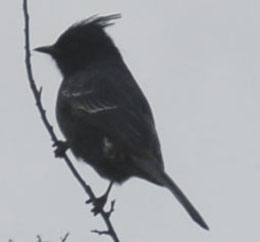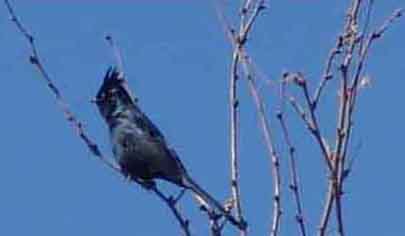Silky Flycatchers: Phainopepla (Phainopepla nitens)
Silky Flycatchers are tropical to subtropical songbirds, typically with short bills and soft silky plumage, long slender tails, and (in most species) distinctive crests. They also have "conspicuous rictal bristles" [Sibley 2001, pp. 18, 489] -- bare, hair-like shafts around the mouth, a feature most developed on active flycatchers. The only regular North American species of this family is the Phainopepla, which is also the only species that displays evident sexual differences; males are black, females gray. Phainopeplas catch insects on the wing (and also conduct spectacular flights during mating), but their main food is Mistletoe, with which they have a close symbiosis: they build their nests mainly in mesquite trees (where Desert Mistletoes reside), near a mistletoe plant, which they eat and then excrete the sticky seeds in new trees. They also eat Juniper and other kinds of berries, but their geographic distribution is closely linked to that of Mistletoe. Below, on March 20, 2008 a phainopepla male sits atop prize foodstuffs: a tree crowned with mistletoe along the Cascabel Road:

We see them in Saguaro Juniperland at their densest in January and February, when the birds perch at or near the very tops of their trees -- see the accompanying photographs (and click on the images to enlarge them). One January driving the Cascabel Road, we saw more than a dozen individual birds, each perched as the ones shown, and distributed a mile + apart along the road. We stopped to photograph several of them on a gray day in February 2005, and found that when we reached a certain distance they would fly away, but only to a nearby treetop. When we approached that tree, they would then fly back to the previous one. This bird has an orange eye with black pupil, and when they fly adult males show a stong white patch on their primary feathers.
According to Sibley (op. cit., p. 489), our Phainopeplas first breed here in January. Males build the nest, feed the female, and both parents feed the chicks crushed berries and insects. Then they move to higher and moister habitats (oak woodlands and chaparral, both in California and Arizona) in April and May, and may nest a second time.
Below, several images of adult males:
 ...
... ...
...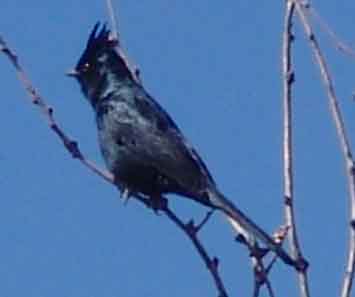 ...
...
Below are three images of either a female or a juvenile male, photographed near Teran Wash Confluence with the San Pedro River in March 2007: (Click on the images to enlarge them.)
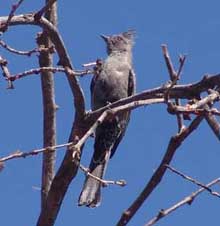 .
. .
.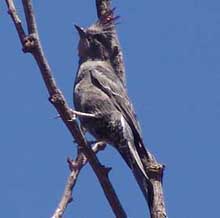 .
.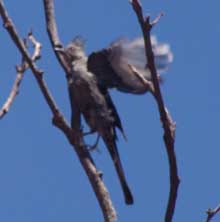
Phainopepla females are ash-gray in color, but possess whitish edges on all their wing feathers (Sibley 2000:422). Juvenile males are similar, but gradually acquire their black feathers during the first year. Note that this bird raises its wings at right to reveal whitish outer primaries, and since adult males (but not females) possess such whitish patches (which display conspicuously in flight), this bird is probably a juvenile male. It flew up to and displaced a male bird on the same tree just before these pictures were taken.
Return to Birds
